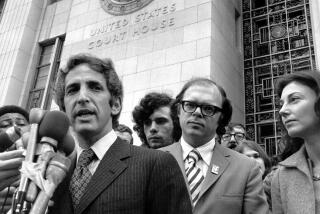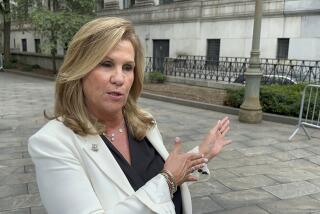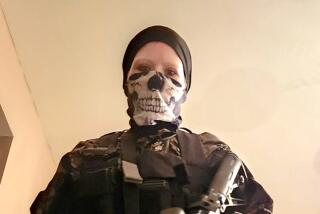Terrorism Case Shows U.S. Flaws in Strategy
- Share via
DETROIT — When federal agents went through the apartment door just before sunrise on Sept. 17, 2001, Glock automatics at the ready, what they found caused government officials all the way to the top of the Justice Department to snap to attention.
Less than a week after Islamic extremists attacked the World Trade Center and the Pentagon, here were three North African Muslim men caught in a barren apartment with airport security passes, forged passports, videotapes of American landmarks and a crude sketch labeled in Arabic an “American base in Turkey.”
They also had virulent jihadist tapes, including a rant against Christians and Jews that said, “Allah, kill them all. Don’t keep any of them alive.”
Atty. Gen. John Ashcroft proclaimed the breakup of a dangerous terrorist cell. Less than two years later, Detroit yielded the first trials and convictions of alleged terrorists in the United States after Sept. 11.
But the seemingly brilliant prosecution soon imploded.
Today, the terrorism convictions have been dismissed because the government withheld evidence that could have helped the defense. The Justice Department is investigating its chief prosecutor in the case, Richard G. Convertino. He, meanwhile, is suing the department.
The waters are so muddied that it may never be known whether the defendants were involved in terrorism or not. Even now, prosecutors admit they cannot show that the defendants had any contact with a terrorist organization, and they don’t know if any attack was planned.
And the Detroit case laid bare a problem in the government’s basic strategy. To forestall attacks, officials have adopted the domestic equivalent of President Bush’s doctrine of preemptive action. But prosecuting suspects before they strike forces the investigators into the murky world of intent, where pitfalls abound.
Evidence can be ambiguous, solid testimony scarce. It’s up to prosecutors to distinguish between terrorists and hapless immigrants with phony papers.
“There’s an expression that you sometimes fall in love with your case,” Keith Corbett, Convertino’s trial partner, said. “There was just so much emphasis in trying to address the war on terror.”
The problems grow when officials are fighting with one another instead of working together. And the Detroit case was rife with personal animosity. To Convertino, politically motivated Washington officials had a vendetta against him. To Ashcroft’s Justice Department, Convertino was an overzealous prosecutor who ignored defendants’ rights.
U.S. District Judge Gerald E. Rosen, who handled the case, warned that the war against terrorism must never be an excuse for trampling on the Constitution.
“Unfortunately,” he added, “that is precisely what has occurred in the course of this case.”
*
When federal agents went to the two-story duplex south of downtown Detroit, they were seeking Nabil al-Marabh, No. 27 on a terrorism watch list. Instead they found three immigrants from North Africa.
Karim Koubriti answered the door in boxer shorts and a T-shirt. He said Al-Marabh had moved out.
Ahmed Hannan and Farouk Ali-Haimoud were sleeping on the floor, their clothes stored in trash bags.
Agents spotted security badges from Detroit Metropolitan Airport, fraudulent ID cards and other phony documents. In a day planner, they found a notation in Arabic that read, “American base in Turkey,” and a sketch that some analysts said depicted an airport flight path. Videotapes showed such landmarks as Disneyland. The three men insisted that the day planner and tapes were not theirs. They described themselves as itinerant workers who washed dishes at the airport.
They were arrested, and other arrests followed.
Youssef Hmimssa, whose photo had been found in the apartment, was picked up in Cedar Rapids, Iowa. Another associate, Abdel-Ilah Elmardoudi, was grabbed off a bus in North Carolina carrying $90,000 in cash and fraudulent documents.
The suspects, in their 20s and 30s, were charged with providing material support or resources to terrorists -- all but Hmimssa, who became the prosecutors’ star witness.
Convertino came to believe that the defendants were scouts for terrorists. He developed evidence suggesting that Ali-Haimoud had planned to send money and weapons to “the brothers in Algeria,” and that Hannan had memorized the layout of the U.S. Embassy in Amman, Jordan. There were indications that Elmardoudi had gone to Turkey using aliases.
*
In many ways, Convertino is a prosecutor cut in the Ashcroft mold: religious and righteous, patriotic but polarizing.
The 42-year-old son of Italian immigrants, he is a devout Catholic and father of five. He is known for gestures of generosity -- collecting money to buy winter gloves for the homeless -- as well as a tenacity that is not confined to the courtroom. He keeps a picture of Gen. George Armstrong Custer in his office.
“What’s wrong with being an admirer of Custer? He only lost once,” Convertino quipped in an interview.
A cigar aficionado, he is a favorite of Detroit FBI agents, who like his courtroom drive. Colleagues say he is well prepared and “quick on his feet.” But Convertino had an abrasive edge. “Rick went out of his way to antagonize people,” a Detroit colleague said. “If you disregarded him, he would dismiss you as an idiot.”
Those who did battle with Convertino saw an even more troubling side. William Swor, who defended Elmardoudi, described Convertino as “someone who cuts corners.”
Trial preparation was daunting, with numerous trips in the United States and overseas, and hundreds of Arabic documents and tapes to translate. In Turkey, Convertino climbed atop a warehouse for a better view of the air base.
Ominously, relations between the Detroit prosecutors and Washington officials began to sour.
With the case in the national spotlight, Washington’s terrorism task force, led by Barry Sabin, was soon immersed in the activities of Convertino’s team. According to the prosecutor, demands from Washington came almost daily.
With the trials just weeks away, Sabin decided the indictment needed reworking. He ordered prosecutors to clear their calendars for a meeting. When he arrived, the atmosphere grew testy. After Sabin asked where prosecutors had gotten the legal reasoning in one part of the indictment, Convertino replied sharply.
“I pulled it out of my ... ,” Convertino recalled saying.
Later, Sabin set the Detroit prosecutors fuming by assigning department lawyer Joseph Capone to monitor the trial. “I have never seen anything approaching this level of micromanagement,” Corbett e-mailed the U.S. attorney in Detroit, Jeffrey Collins.
Convertino and Corbett insist that they tried to include Capone, but said all he seemed to want to do was sit back in the courtroom and take notes for Sabin.
Capone says he was frozen out.
A high-ranking Justice Department official said Convertino “ignored things he was told to do by us.”
“He really, really, really wanted to have a piece of 9/11,” the official said. “He wanted to be the hero.”
*
The trial began March 27, 2003.
Government experts explained some of the drawings as target sketches of the air base in Turkey. Other experts said the videotapes of landmarks were the kind terrorists made when casing a target.
On the stand, Hmimssa described dangerous schemes he said his former associates were hatching. He said he bowed out when he began to suspect them of plotting terrorism.
But as defense lawyers cross-examined Hmimssa, Capone grew concerned. He knew prosecutors had a letter from a Detroit jail inmate saying Hmimssa had told him of lying to federal agents in an earlier incident. If prosecutors had disclosed it, why wasn’t the defense using the letter to impeach Hmimssa?
The way Capone had learned of the letter suggested how much bad blood surrounded the case. Another Detroit prosecutor had told Capone about it, but instead of discussing it with Convertino, Capone had gone to their superior, Alan Gershel, head of the criminal division in Detroit.
The inmate’s letter would later explode into an issue that destroyed the prosecution, but for now it was just a sign of mistrust inside what was supposed to a team.
Meanwhile, Convertino closed strong. “This is a dangerous group,” he told jurors. “This was a pre-operational cell, a cell that was stopped, a cell that was caught.... These people belong in prison.”
On June 3, 2003, Elmardoudi and Koubriti were convicted of terrorism-related charges, as well as ID fraud. Hannan was acquitted of charges linked to terrorism but convicted of ID fraud. Ali-Haimoud was acquitted on all counts.
Publicly, Convertino’s bosses in Detroit and Washington hailed the verdicts, but a month later Convertino and Corbett were summoned to separate meetings with U.S. Atty. Collins.
Corbett expected a pat on the back, but emerged red-faced.
With Convertino, Collins started out praising the closing arguments, then got to the point. As Convertino described it, Collins said, “I’ve been ordered to reprimand you” for not cooperating with Washington.
*
In late summer, Convertino got a call from an aide to Sen. Charles E. Grassley (R-Iowa), chairman of the Senate Finance Committee, asking Convertino to testify about identity fraud.
Alarms went off at Justice. Grassley was a fierce critic of the department and an ardent protector of whistle-blowers. The day after telling his boss about the Grassley invitation, Convertino said, he was taken off the terrorism case.
When Grassley found out, he complained to Ashcroft about apparent retaliation. Then he subpoenaed Convertino to appear before his committee.
When Convertino testified, Justice Department officials sat behind him. He did not criticize Washington, but he was already seen as “off the reservation,” Convertino said later.
Within days, Collins had assigned three lawyers to review Convertino’s cases dating back to the mid-1990s.
The terrorism case was reassigned to Assistant U.S. Atty. Eric Straus. And as Straus reviewed the files, he turned to Capone, who pointed to the letter written by the inmate, gang leader Milton “Butch” Jones, who was accused of drug dealing and murder.
Jones and Hmimssa had been in the same cell block. Jones said Hmimssa told him “how he lied to the FBI, how he fooled the Secret Service agent on his case.”
Convertino got a copy of the letter more than a year before trial. But he and Corbett chose to view Jones as trolling for a deal. Jones was not credible, they decided, and they did not give his letter to the defense.
When Straus saw the letter after the trial, he told his bosses and attorneys for the defendants. They sought a new trial. Outraged, the judge ordered a hearing to sort the matter out.
Last December, prosecutors and defense lawyers crowded into Rosen’s courtroom. Also on hand were Capone, Hmimssa and Jones.
Jones refused to talk. Hmimssa admitted talking to Jones -- “We played chess, we exchanged books” -- but denied telling Jones he had lied to the FBI or other authorities.
Gershel told the judge he had ordered the Jones letter handed over before the trial ended. But Corbett and Convertino said they never got such an order.
Besides, during cross-examination, Hmimssa had admitted lying to federal agents.
At the close of the daylong session, Rosen put off sentencing Elmardoudi and Koubriti, saying, “I’m going to get to the bottom of this.”
In February, Ashcroft appointed a Cleveland prosecutor, Craig Morford, to investigate whether other potentially exculpatory evidence had been withheld. Morford reported finding a pattern of prosecutorial misconduct.
At trial, the prosecution had relied extensively on an Air Force officer who said she was positive the day planner sketches were diagrams of the air base in Turkey. But Morford found a report in prosecution files that suggested that other Air Force officials saw the diagrams differently.
An Air Force special agent had described some of the interpretations as “highly speculative.” The CIA had termed the sketches virtually meaningless.
“In its best light,” Morford told Rosen, “the record would show that the prosecution committed a pattern of mistakes and oversights that deprived the defendants of discoverable evidence.”
Speaking for the government, Morford recommended dismissing the terrorism convictions.
Convertino disputes many of Morford’s findings. He says he did not learn of the Air Force and CIA doubts until after the trial.
“This is retaliation; it’s an absolute shame what they’re doing,” Convertino said. “It’s more important to destroy me and destroy the case than it is to fight the war on terrorism.”
Last month, three days after getting Morford’s report, the judge dismissed the terrorism-related convictions and ordered new trials on the ID fraud convictions. Defense lawyers hope the remaining charges will be dropped.
*
The man the FBI originally went looking for three years ago, Al-Marabh, had been found two days later working in his uncle’s Chicago-area liquor store.
He was detained on material witness warrants, shipped to Brooklyn and Buffalo, N.Y.; Chicago and Detroit, and held for long stretches without access to an attorney. Finally -- like the vast majority of post-Sept. 11 terrorism arrestees -- he pleaded guilty to an immigration violation and was deported.
Prosecutors concede that no evidence was ever found connecting Al-Marabh with “any terrorist activity or terrorist organization.”
More to Read
Sign up for Essential California
The most important California stories and recommendations in your inbox every morning.
You may occasionally receive promotional content from the Los Angeles Times.










